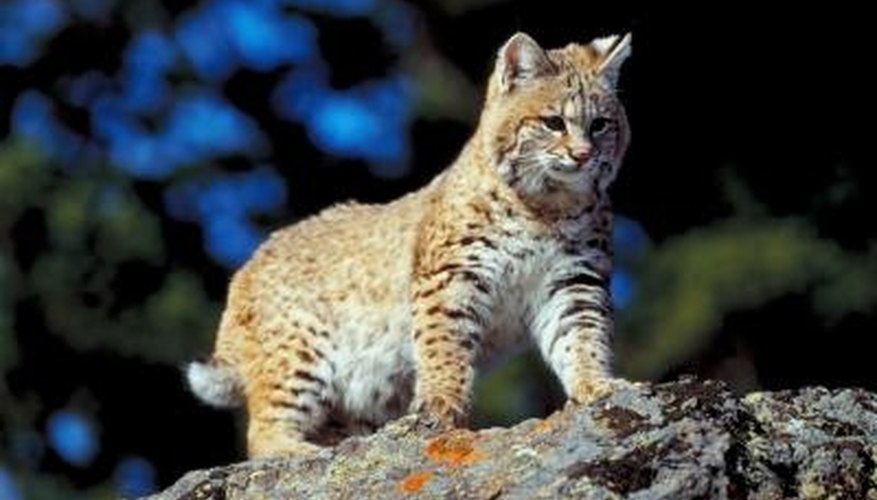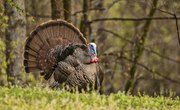
Bobcats are highly adaptable predators with amazing instincts. They are the most common wild feline in the world, making its home in forests, swamps, semi-deserts and densely populated suburbs. The bobcat's key to survival is its mastery of habitats and its acute senses. The big cat is naturally suspicious, clever and sneaky. They eat rabbits, small rodents, grasshoppers, crayfish, raccoons, prairie dogs, porcupines, bats, snakes, birds and occasionally deer during the winter. Using a combination of a whistle, food, catnip, anise oil, feather and mineral lick will help attract bobcats. Whistles mimic the distress calls of a wounded rabbit, bird or fawn. There are several varieties that will attract bobcats, including mouth-blown predator whistles and closed-reed, barrel-type and open-reed whistles.
Items you will need
Camouflage clothing
Deer stand
Corn
Catnip
Anise oil
Mineral lick
Feather
String
Whistle
Put on your camouflaged apparel. This will help because the bobcat's eyesight is keen.
Get out of your vehicle quietly and find an area at least 60 to 100 yards away from the vehicle.
Look for primary rabbit habitat, such as bushes and brushy thickets, searching for rabbit signs such as droppings and tracks. Bobcats will be in areas they are most likely to catch a rabbit.
Set up your deer stand at sunrise and wait until around 10 a.m. Bobcats will rest and remain out of sight throughout the day, and be active again at dusk and through the night.
Place a small amount of corn, catnip and the mineral lick near the area on the ground. The corn and mineral lick attracts small animals that will result in attracting the bobcat.
Wipe several drops of anise oil on a nearby tree, approximately 2 feet above the ground.
Hang a feather on a nearby bush using the string, approximately 3 feet from the ground, allowing the breeze to move it. The movement will attract the bobcat's curiosity.
Move to your deer stand and whistle, imitating a rabbit's distress cries. When a predator catches a rabbit, the rabbit shrieks. Bobcats are familiar with this sound and listen for it to find an easy meal. Blow into the whistle gently, beginning with a series of low whistles, gradually increasing in volume.
Perform a series of 30-second calls, pausing in between. A bobcat does not associate the sound of the call with the hunter. If you miss him the first time, you can call him again.
Sit quietly and remain alert. A bobcat may take 30 minutes or longer to be coaxed from hiding.
Warnings
- Bobcats are expert hunters. Do not underestimate them. If cornered or threatened, they are extremely dangerous.
- Do not approach bobcat kittens even if they are abandoned. The female will likely be in the immediate area, even if unseen.
- The methods used to attract a bobcat can also attract other dangerous predators such as bears.
- When calling, a bobcat will not run up to you like a fox or coyote. It will likely sneak up on you before you are aware it is there.
Tips
- Bobcats can be called year-round, but can be hunted only during hunting season. Find out when hunting season is legal in your state.
- Bring a partner, map, compass, sufficient water and food.
- Calling is best when there is no wind. If it is windy, ensure it is coming toward you, so that the cat cannot catch your scent.
Tips
- Bobcats can be called year-round, but can be hunted only during hunting season. Find out when hunting season is legal in your state.
- Bring a partner, map, compass, sufficient water and food.
- Calling is best when there is no wind. If it is windy, ensure it is coming toward you, so that the cat cannot catch your scent.
Warnings
- Bobcats are expert hunters. Do not underestimate them. If cornered or threatened, they are extremely dangerous.
- Do not approach bobcat kittens even if they are abandoned. The female will likely be in the immediate area, even if unseen.
- The methods used to attract a bobcat can also attract other dangerous predators such as bears.
- When calling, a bobcat will not run up to you like a fox or coyote. It will likely sneak up on you before you are aware it is there.
Writer Bio
Based in Colorado, Charmaine Jens began her writing career as an editor and technical writer. Her professional experience includes work in executive administration and serving as a resume editor, specializing in military transition clients. Jens holds a Master of Business Administration from Colorado Mesa University.



